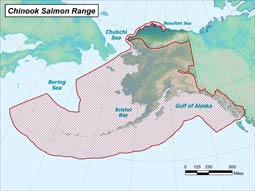Chinook Salmon
(Oncorhynchus tshawytscha)
Species Profile
Did You Know?
Chinook salmon are called “Kings” in reference to their large size.
Chinook Salmon Research Initiative
General Description
The Chinook salmon is the largest of all Pacific salmon, typically measuring 36 inches in length, often exceeding 30 pounds. Adults are distinguished by the black irregular spotting on the back and dorsal fins and on both lobes of the caudal or tail fin. Chinook salmon also have a black pigment along the gum line, thus the name "blackmouth" in some areas.
In the ocean, the Chinook salmon is a robust, deep-bodied fish with bluish-green coloration on the back which fades to a silvery color on the sides and white on the belly. Colors of spawning Chinook salmon in fresh water range from red to copper to deep gray, depending on location and degree of maturation. Males typically have more red coloration than females, which are typically gray. Older adult males (4-7 years) are distinguished by their "ridgeback" condition and by their hooked nose or upper jaw. Females are distinguished by a torpedo-shaped body, robust mid-section, and blunt noses. Juveniles in fresh water (fry) are recognized by well-developed parr marks which are bisected by the lateral line. Chinook salmon heading to the ocean (smolt) have bright, silver sides, and parr marks recede to mostly above the lateral line.
Life History
Like all species of Pacific salmon, Chinook salmon are anadromous. They hatch in fresh water and rear in main-channel river areas for one year. The following spring, Chinook salmon turn into smolt and migrate to the salt water estuary. They then spend anywhere from 1-5 years feeding in the ocean, and return to spawn in fresh water. All Chinook salmon die after spawning. Chinook salmon may become sexually mature from their second through seventh year, and as a result, fish in any spawning run may vary greatly in size. For example, a mature 3-year-old will probably weigh less than 4 pounds, while a mature 7-year-old may exceed 50 pounds. Females tend to be older than males at maturity. In many spawning runs, males outnumber females in all but the 6- and 7-year age groups. Small Chinook salmon that mature after spending only one winter in the ocean are commonly referred to as "jacks," and are typically male. Alaska streams normally receive a single run of Chinook salmon in the period from May through July.
Chinook salmon often make extensive freshwater spawning migrations to reach their home streams on some of the larger river systems. Yukon River spawners bound for the extreme headwaters in Yukon Territory, Canada, will travel more than 2,000 river miles during a 60-day period. Chinook salmon do not feed during the freshwater spawning migration, so their condition deteriorates gradually during the spawning run as they use stored body materials for energy and gonad development.
Each female deposits between 3,000 and 14,000 eggs in several gravel nests, or redds, which she excavates in relatively deep, fast moving water. In Alaska, the eggs usually hatch in late winter or early spring, depending on time of spawning and water temperature. The newly hatched fish, called alevins, live in the gravel for several weeks until they gradually absorb the food in the attached yolk sac. These juveniles, called fry, wiggle up through the gravel by early spring. Chinook juveniles divide into two types: ocean type and stream type. Ocean type Chinook migrate to saltwater in their first year. Stream type spend one full year in fresh water before migrating to the ocean. In Alaska, most juvenile Chinook salmon remain in fresh water until the following spring when they migrate to the ocean as smolt in their second year of life.
Juvenile Chinook salmon in fresh water initially feed on plankton and later feed on insects. In the ocean, they eat a variety of organisms including herring, pilchard, sandlance, squid, and crustaceans. Salmon grow rapidly in the ocean and often double their weight during a single summer season.
Range and Habitat
Fresh water streams and estuaries provide important habitat for spawning chinook, and they also serve as nursery grounds for developing eggs, fry, and juveniles. In North America, Chinook salmon range from the Monterey Bay area of California to the Chukchi Sea area of Alaska. On the Asian coast, Chinook salmon occur from the Anadyr River area of Siberia southward to Hokkaido, Japan. In Alaska, they are abundant from the southeastern panhandle to the Yukon River. Major populations return to the Yukon, Kuskokwim, Nushagak, Susitna, Kenai, Copper, Alsek, Taku, and Stikine rivers. Important runs also occur in many smaller streams.
Status, Trends, and Threats
National Status: N4 (Apparently Secure)
Implied Status under the U.S. Endangered Species Act: PS (Partial Status - status in only a portion of the species' range
Trends and Threats: There are numerous stocks of Chinook throughout the state and their population trends are just as diverse: Some stocks are in decline while others are at equilibrium or increasing. Threats include overfishing, dams, habitat loss, habitat degradation, and climate change.
Fast Facts
-
Size
Length = 36 inches (Record: 58 inches); Weight = 30 lbs (Record: 126 lbs). -
Lifespan
3 to 7 years -
Distribution/Range
North America "– Monterey Bay, CA' to the Chukchi Sea. Asia – Hokkaido, Japan to Anadyr River, Siberia -
Diet / Feeding Type
Plankton, insects, amphipods, and fish -
Predators
Birds and fish eat juveniles; marine mammals eat adults -
Reproduction
Anadromous and semelparous -
Remarks
On March 25th 1963, the Chinook salmon became the official state fish of Alaska -
Other Names
Chinook, chins, king. quinnat, tyee, tule, blackmouth, and spring salmon.


